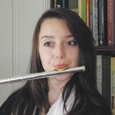Traditionally when flutists practice intervals, they play half-steps very slowly up and down the range of the flute. However, when playing solo, chamber or ensemble repertoire, it is the larger intervals that cause problems with accurate intonation, a beautiful sound, and well-chosen colors. The following exercises explore the intervals of the minor second, major second, minor third, major third, perfect fourth, augmented fourth, perfect fifth, augmented fifth, minor sixth, major sixth, minor seventh and major seventh. (The exercises may be found here.)
An interval may be defined as the distance between two notes. The name of each interval shows the number of tones of the diatonic scale it includes. For example, C to D is a second. C to E is a third. The intervals of a second, third, sixth and seventh may be diminished, minor, major, or augmented while the intervals of the fourth, fifth, and octave may be perfect, diminished, or augmented. The inversion of an interval means that the lower note becomes the higher tone. Nine is the magic number to remember. If a second is inverted, it becomes a seventh. (2 + 7 = 9). A third when inverted becomes a sixth. (3 + 6 = 9). Intervals greater than an octave are called compound intervals.
Practice this exercise at a slow tempo with measured or counted vibrato. A good starting place is four or five vibrato cycles per quarter with the metronome set on 60. You may choose to do the same interval page every day for a week, or you may cycle through the eleven pages practicing a different page each day. During the course of your practice vary the number of vibrato cycles per quarter note and increase the tempo playing at each tick on the metronome from 60 to 80 BPM. When you reach 80, start over at 60 at the next practice session.
Construct seamless slurs with the same color on each of the three notes. A listener should not be aware that the flute has a low octave, a middle octave, and a high octave. Strive for a homogenous color throughout the range. At first practice mf until you develop your embouchure and then experiment playing at a variety of dynamic designs and with diminuendos and crescendos.
Joseph Mariano (legendary professor of flute at the Eastman School of Music) said in a lesson to me one day, “Remember you can play low notes on a high embouchure, but not high notes on a low embouchure.” When you are practicing these intervals, experiment to see whether you get better results by changing the size of the aperture or by increasing the speed of the air. There is no one answer. When you discover what works best for you on your specific flute, the choice will be exclusive to you.
Use the tuner so you develop a memory of where your lips are placed for each note in the intervallic succession. Video yourself to check that your upper face is not tense while executing the intervals. Also use the video to check finger position and movement. The fingers should move articulately from the third knuckle back (except for the left index thumb and finger) and touch the flute in the center of each key. With the larger intervals, it is easy to remove fingers in a ripple effect rather than all at once. Good timing is the key to success. Check to be sure that the vibrato cycles do not stop when you move your fingers. At first this exercise may seem tedious, but after a few weeks, you will love what it adds to your flute performance.






